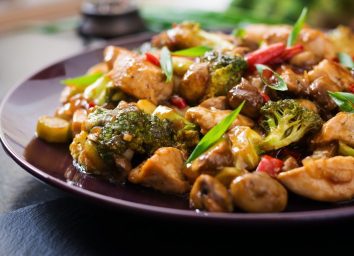23 Best and Worst Items in the Asian Foods Aisle
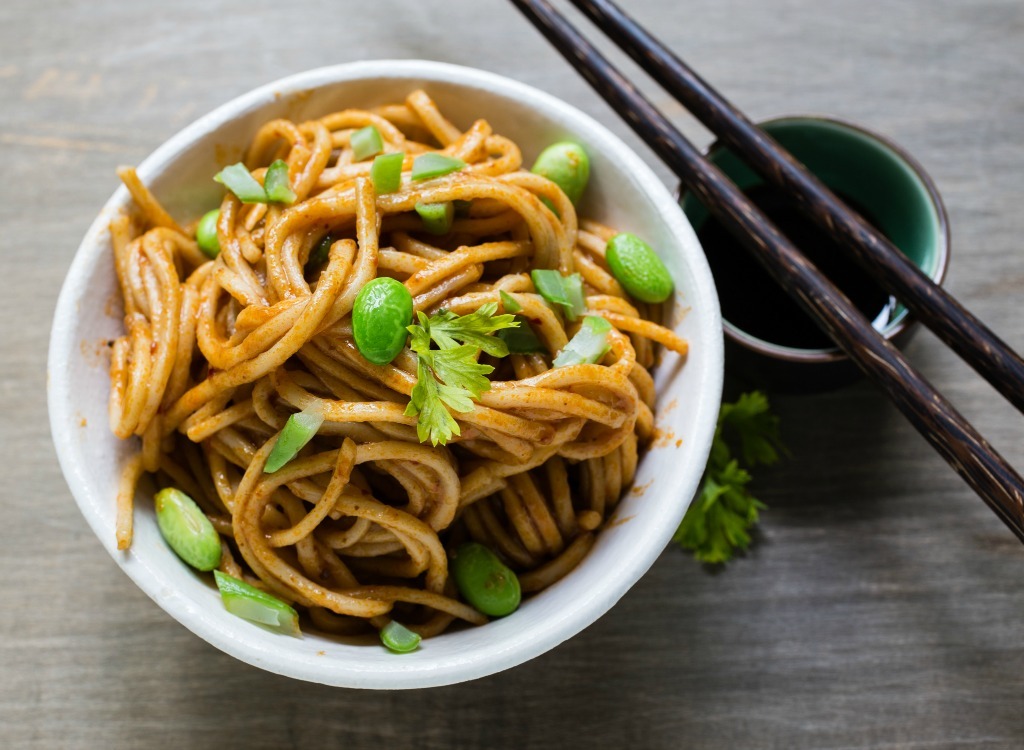
My fiancé is obsessed with Chinese food. Before we lived together, he’d order takeout to celebrate a big win. He’d order takeout after a rough day. He even ordered takeout when trying to lose weight! No matter what was going on in his life, General Tso’s chicken and wonton soup were the answer.
I, too, have a love for Chinese food, but I also know just how calorie-, fat- and salt-filled orange chicken, egg rolls, and other popular dishes can be. That’s why I often craft Asian-inspired dishes for us at home, with the help of pre-made sauces and other products in my supermarket.
I’m not alone. As of 2012, non-restaurant sales of Asian foods topped $1.5 billion, according to market research firm Mintel Group, and the demand for this stuff has only skyrocketed since. Think about it; you can now buy green tea matcha at Starbucks and sushi at a drug store. Crazy!
But here’s where things get tricky: not all supermarket stir-fry sauces, Asian noodles, and frozen entrees are better than the stuff that comes from your local delivery joint. And considering just how gross some options can be (a standard order of chow mein has more than 500 calories and a half day’s salt), that’s saying a lot!
To help stay on track toward your goals, we’ve outlined the best and worst options in the Asian foods aisle. Stay away from our Not That! picks and you’ll be able to eat your favorite Chinese food dishes and lose weight, too! But before you fill your cart with the best of the lot, be sure to check out these 30 Ways to Save at the Grocery Store—Without Coupons!
Soy Sauce
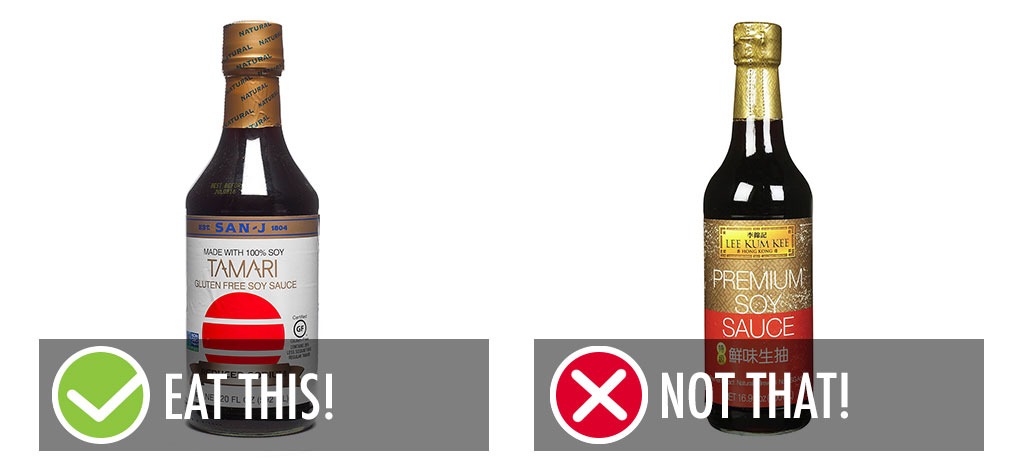
Eat This
San-J Tamari Gluten Free Soy Sauce, Reduced Sodium
Per Tbsp: 15 calories, 0 g fat, 0 g saturated fat, 710 mg sodium, 1 g carbs, 0 g fiber, 0 g sugar, 2 g protein
Not That!
Lee Kum Kee Premium Soy Sauce
Per Tbsp: 15 calories, 0 g fat, 0 g saturated fat, 1,030 mg sodium, 2 g carbs, < 1 g sugar, 0 g fiber, 1 g protein
Soy sauce: it’s the stuff used to make a million different Asian dishes and the dipping sauce of choice for sushi lovers. The trouble is that many popular bottles, including Lee Kum Kee Premium Soy Sauce, contain over 40 percent of your day’s salt in a mere tablespoon! Which makes sense considering the majority of the bottle is filled with salt and water. What else is in the bottle? Sugar, soybeans, and chemicals. Lots and lots of chemicals—one of which is sodium benzoate. In one study of the effects of sodium benzoate on living yeast cells, researchers found benzoate to be damaging to mitochondria, an important area of DNA. Not only is our Eat This pick lower in sodium, it has just four ingredients—all of which are easy to pronounce.
Asian Salad Dressing
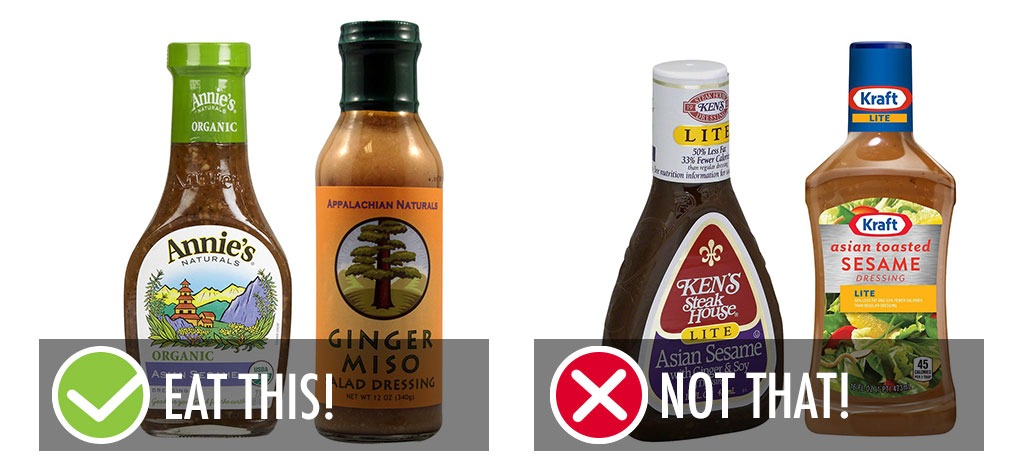
Eat This
Appalachian Naturals Salad Dressing Gluten Free Ginger Miso
2 Tbsp: 60 calories, 7 g fat, 0 g saturated fat, 140 mg sodium, 1 g carb, 0 g fiber, 1 g sugar, 1 g protein
Annie’s Naturals Organic Dressing Asian Sesame
2 Tbsp: 120 calories, 12 g fat, 1 g saturated fat, 290 mg sodium, 4 g carbs, 0 g fiber, 3 g sugar, 0 g protein
Not That!
Ken’s Steak House Lite Asian Sesame with Ginger & Soy Dressing
2 Tbsp: 70 calories, 4 g fat, 0.5 g saturated fat, 390 mg sodium, 8 g carbs, 0 g fiber, 7 g sugar, 1 g protein
Kraft Light Asian Toasted Sesame Salad Dressing
2 Tbsp: 45 calories, 1.5 g fat, 0 g saturated fat, 260 mg sodium, 2 g carbs, 0 g fiber, 6 g sugar, 0 g protein
After water, sugar is the first ingredient in Ken’s bottle which is why each serving packs 7 grams of the sweet stuff. Unsurprisingly, Kraft’s creation is also high in sugar. The reason: when food manufacturers nix fat (a nutrient that actually helps your body use all of the vitamins in your salad veggies) from their recipes, they often add sugar to make up for the flavor. The featured Not That! products are also filled with things like MSG (a flavor enhancer that blocks the “I’m full” hormone), caramel color (a potential carcinogen), and EDTA (a flavor protector that’s been shown to interfere with nutrient absorption), making them hardly worth their low-calorie counts. Drizzle your Asian-inspired salads with our approved dressings to ensure you’re keeping scary ingredients and excess sugar off of your plate.
Teriyaki Sauce
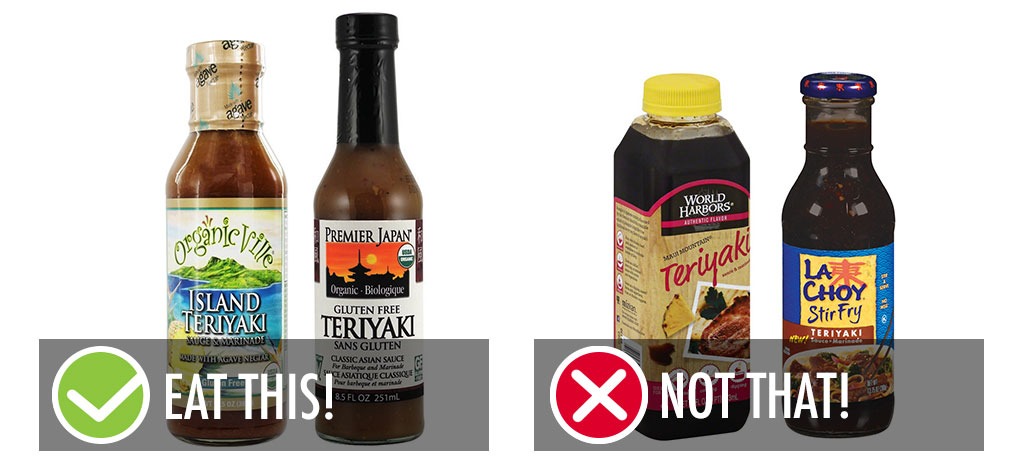
Eat This
Organicville Organic Island Teriyaki Sauce
Per Tbsp: 25 calories, 1 g fat, 0 g saturated fat, 240 mg sodium, 4 g carbs, 0 g fiber, 3 g sugar, < 1 g protein
Edward & Sons Organic Teriyaki Sauce Gluten Free
Per Tbsp: 15 calories, 0 g fat, 0 g saturated fat, 250 mg sodium, 3 g carbs, 0 g fiber, 2 g sugar, 0 g protein
Not That!
World Harbors Sauce & Marinade Teriyaki
Per Tbsp: 40 calories, 0 g fat, 0 g saturated fat, 110 mg sodium 10 g carbs, 0 g fiber, 10 g sugar, 0 g protein
La Choy Stir-Fry Teriyaki Sauce Marinade
Per Tbsp: 10 calories, 0 g fat, 0 g saturated fat, 105 mg sodium, 3 g carbs, 0 g fiber, 1 g sugar, 0 g protein
Free of preservatives, corn syrup, and fake coloring, and lower in sugar than its shelf mates, Organicville and Edward & Sons’ teriyaki sauces both get the green light. For a meal in less than 15 minutes, toss some plain, frozen Asian-style veggies into a frying pan or wok with a tablespoon or two of teriyaki and some cubed chicken. If you have some additional time on your hands, boil some water and serve the meat and veggie combo over a bed of brown rice or quinoa. For some added flavor, consider chopping up some fresh pineapple. It pairs great with teriyaki stir-fries—and plays a starring role in all of these 20 Pineapple Recipes You’ll Fall In Love With.
Frozen Egg Rolls
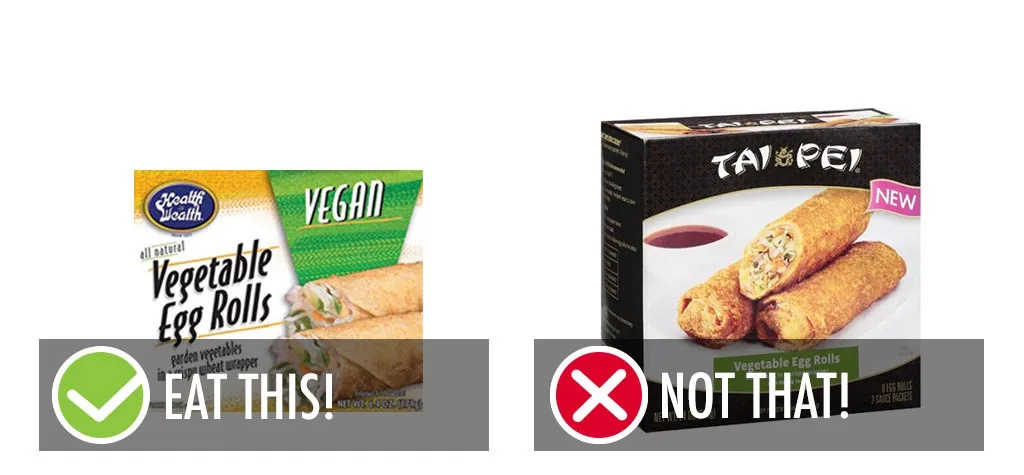
Eat This
Wealth is Health Vegetable Egg Rolls
1 roll, 85 grams: 130 calories, 4 g fat, 0 g saturated fat, 550 mg sodium, 21 g carbs, 3 g fiber, 0 g sugar, 4 g protein*
Not That!
Tai Pei Vegetable Egg Rolls
1 roll, 71 grams: 160 calories, 7 g fat, 390 mg sodium, 19 g carbs, 2 g fiber, 3 g sugar, 4 g protein
Summer rolls will always trump egg rolls since they’re steamed instead of fried. But if you’re craving something crunchy, Wealth is Health Vegetable Egg Rolls (which contain cabbage, celery, carrots, sesame seed oil, and yummy spices) beat out Tai Pei’s version. Not only are they larger in portion size, they’re lower in calories and fat and have a shorter ingredient list.
Frozen Entrees
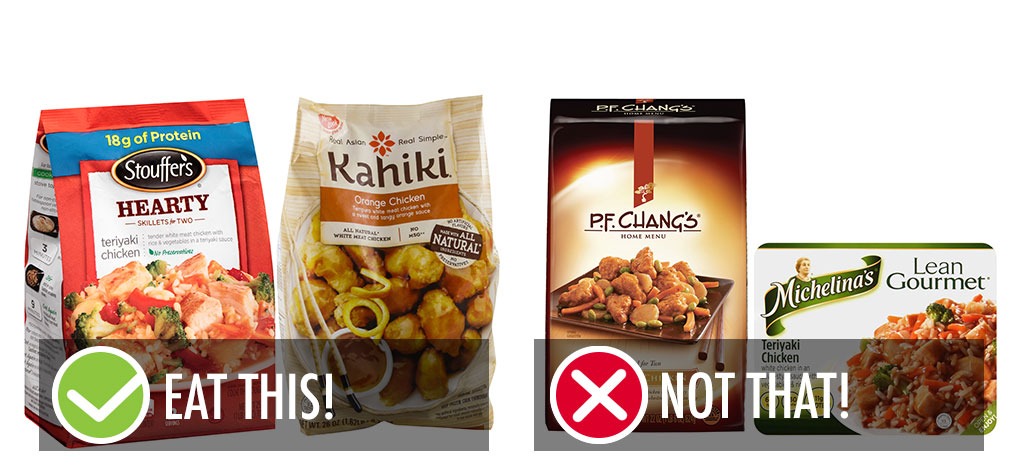
Eat This
Kahiki Orange Chicken
140 g: 300 calories, 15 g fat, 2.5 g saturated fat, 700 mg sodium, 33 carbs, 0 g fiber, 19 g sugar, 9 g protein
Stouffer’s Skillets for Two Teriyaki Chicken
½ package, 354 g: 320 calories, 3 g fat, 1 g saturated fat, 740 mg sodium, 54 carbs, 0 g fiber, 10 g sugar, 17 g protein
Not That!
PF Chang’s Orange Chicken
312 g: 430 calories, 18 g fat, 2.5 g saturated fat, 930 mg sodium, 44 carbs, 6 g fiber, 26 g sugar, 23 g protein
Michelina’s Teriyaki Chicken
Per package, 227 g: 330 calories, 6 g fat, 1 g saturated fat, 840 mg sodium, 59 carbs, 1 g fiber, 11 g sugar, 11 g protein
PF Chang’s orange chicken has nearly half a day’s sodium—no, thank you! But its rival, Kahiki, serves up a fraction of the sodium and fat you’d find in a typical container of takeout and none of the yucky MSG, making it the clear winner of this category. Be sure to pair it with some plain, frozen veggies (or any of these high fiber foods) to up to your fiber intake, and sip on a large glass of H20 to offset the sodium intake. The same suggestion holds true for our Stouffer’s selection. It wins the Eat This crown for carrying less sodium and more protein than its zappable rival, but it’s still considered to be on the salty side and low in fiber, too.
Asian Veggie Burgers
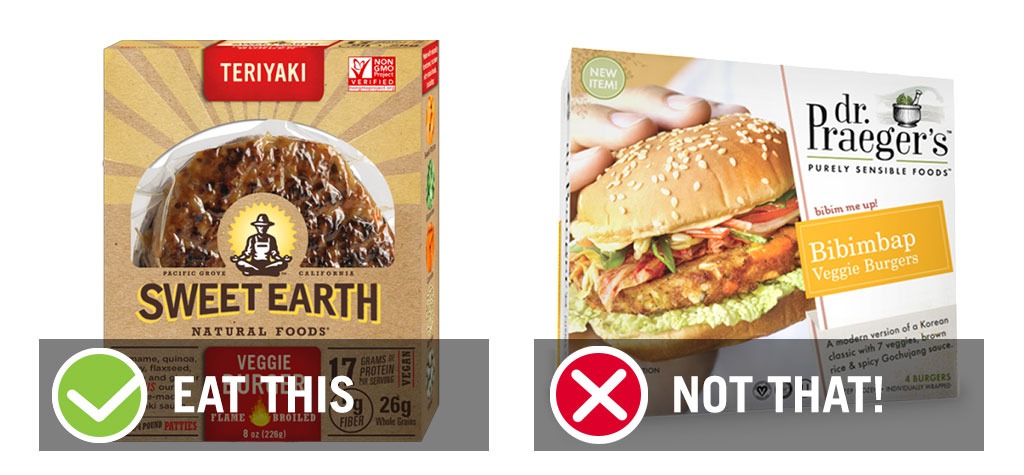
Eat This
Sweet Earth Teriyaki Veggie Burger
Per 4 oz patty, 113 g: 250 calories, 9 g fat (1 g saturated fat), 400 mg sodium, 28 g carbs (5 g fiber, 5 g sugar), 17 g protein
Not That!
Dr. Praeger’s Bibimbap Veggie Burger
Per 2.5 oz patty, 71 g: 150 calories, 8 g fat (1 g saturated fat), 190 mg sodium, 17 g carbs (3 g fiber, 1 g sugar), 2 g protein
Considering it’s made with a blend of things like daikon radishes, gochujang sauce, red miso paste, scallions, and shiitake mushrooms, Dr. Praeger’s Bibimbap burger probably tastes out of this world. The trouble is that it doesn’t provide much in the way of nutrition. You’re getting a measly two grams of protein per patty and a lot of those eight grams of fat are coming from canola oil. For a protein-packed, sizeable patty, go with Sweet Earth’s option. It’s a little high in salt, though, so be sure to pair your meal with a big glass of detox water and steer clear of extra sodium-filled burger toppings.
Noodles
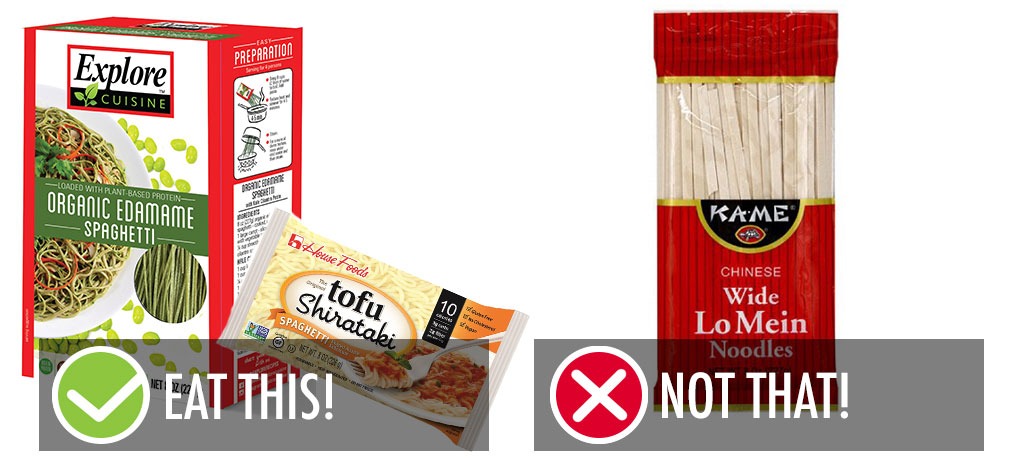
Eat This
House Foods Tofu Shirataki Spaghetti
1/2 package, 113 g: 10 calories, 0.5 g fat, 0 g saturated fat, 15 mg sodium, 3 g carbs, 2 g fiber, 0 g sugar, < 1 protein
Explore Cuisine Edamame Spaghetti
2 oz, 56 g: 201 calories, 2 g fat, 0 g saturated fat, 3 mg sodium, 22 g carbs, 11 g fiber, 5 g sugar, 25 g protein
Not That!
Ka-Me Chinese Wide Lo Mein Noodles
55 grams: 190 calories, 0 g fat, 0 g saturated fat, 210 mg sodium 41 g carbs, 1 g fiber, 1 g sugar, 7 g protein
By now, you’ve likely gathered that Asian food can be salty, and Lo Mein noodles are no exception. By sticking to our Eat This-approved selections, you’ll shave off a fair amount of sodium. While the neutral-flavored House Foods tofu and yam flour noodles are perfect for those watching their calorie intake, the Explore Cuisine noodles (which are made solely from green soybeans, by the way) are a solid bet for those looking to up their protein and fiber intake.
Supermarket Sushi Rolls
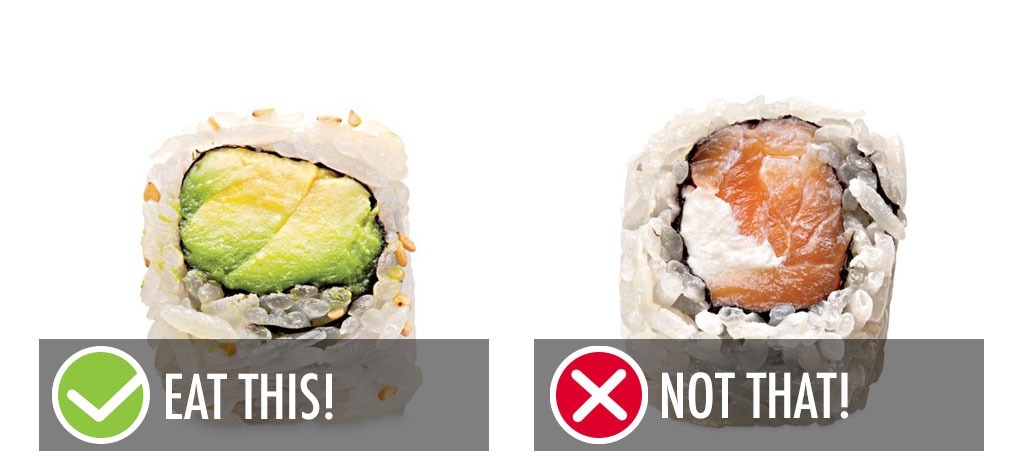
Eat This
Avocado Roll
Per package, 8 rolls: 200 calories, 5 g fat, 1 g saturated fat, 290 mg sodium, 33 g carbs, 3 g fiber, 5 g sugar, 4 g protein
Not That!
Salmon Avocado Roll with Cream Cheese
Per package, 8 rolls: 470 calories, 14 g fat, 3.5 g saturated fat, 710 mg sodium, 66 g carbs, 3 g fiber, 11 g sugar, 18 g protein
It’s not just the calories and fat that makes the salmon and cream cheese roll a Not That! choice; it’s that the quality of the fish is probably sub-par to the stuff found in restaurant rolls, in terms of taste and texture. Plus, if there’s no sushi chef out front rolling your sushi fresh on the daily, you can assume it came from a sushi supplier like Fuji Food Products or Gengi. While their food is perfectly safe to eat (they send their products to places like Target, Walgreens, and Trader Joe’s), you’re better off saving your money for fish-filled rolls in places where it will actually be worth it. At supermarkets, stick to an avocado or veggie roll, and pair it with a homemade Asian-inspired chicken salad topped with one of our ETNT-approved Asian dressings! And speaking of dressings, steer clear of these 16 Salad Dressings Worse Than Chocolate Syrup for when you’ve had your fill of Asian food and choose to nosh on a salad instead.
